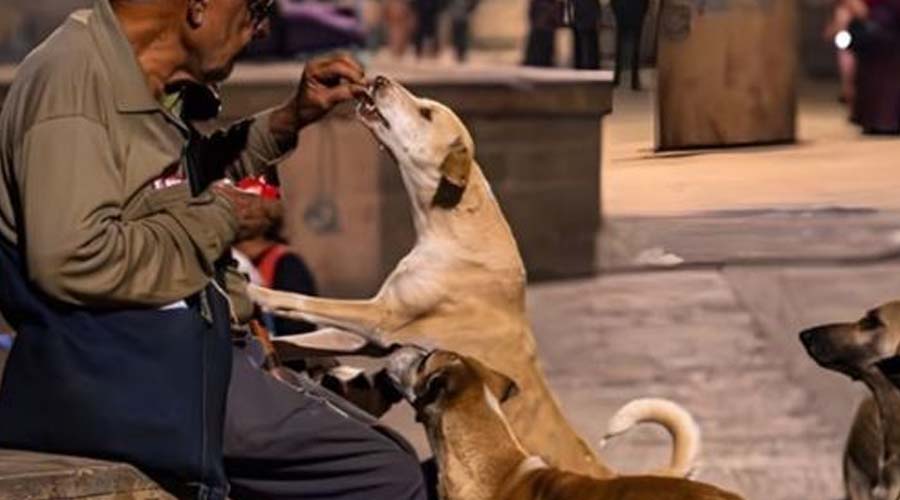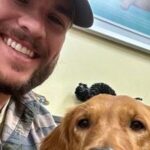I used to think the dogs in our neighborhood just survived off scraps. You know, whatever people tossed out or dropped on the way to the bus stop. But every night, they’d disappear like clockwork—around 8:30, right when the shops were closing. I always wondered where they went.
So one evening after work, I followed them.
There were about six of them—skinny, scrappy things with rib bones showing and tails wagging. They trotted with purpose, cutting through alleyways and skipping the trash piles. I stayed back, curious but not really expecting much.
They stopped at an old stone bench near the underpass. That’s when I saw him.
An older man, probably in his seventies, already seated like he’d been waiting for them. Wore a faded windbreaker, crooked glasses, and shoes with duct tape around the soles. But he smiled like he had everything in the world.
From a battered shoulder bag, he pulled out chapatis, biscuits, even a small bottle of water. One by one, he fed each dog like they were his kids. Some sat. Some jumped. One even rested its paw gently on his knee, like it had done it a hundred times before.
I came back the next night. And the next.
Same spot. Same time. Same man.
I finally worked up the nerve to talk to him, just to ask why. He didn’t answer at first—just kept feeding them. Then he looked at me and said, “They used to come with someone else. But she’s gone now.”
I started to ask who “she” was…
But then one of the dogs limped over, dragging something in its mouth. And what it dropped at my feet made my stomach twist.
It was a wallet. An old leather one, worn smooth from years of use. Inside were a few crumpled bills, some coins, and a picture of a young woman smiling brightly against a backdrop of blooming trees. The photo was faded, but her eyes still sparkled. She looked happy, alive—like someone who’d once filled the world with light.
The old man froze when he saw it. His hands shook as he reached down to pick it up. For a moment, I thought he might cry. Instead, he sighed deeply, clutching the wallet like it was both precious and painful.
“That’s hers,” he said quietly, nodding toward the photo. “Her name was Mira.”
Mira? The name sounded familiar, though I couldn’t place it immediately. As the pieces began to click together, the old man told me her story.
She had been his granddaughter, bright and full of life, working long hours as a nurse while volunteering at animal shelters during her free time. Every evening, without fail, she would bring food to these very dogs. It wasn’t just charity; it was love. She knew each of their names, quirks, and favorite treats. When she passed away suddenly two years ago—a car accident on her way home from a late shift—the dogs stopped coming for weeks. No one understood why until this old man showed up, carrying her same battered bag and feeding them exactly as she had.
“They remember her,” he said softly, watching the dogs eat. “And maybe… maybe they’re trying to take care of me too.”
That night, I left feeling heavy-hearted but also strangely hopeful. Something about the quiet devotion between the old man and the dogs felt profound. I decided to visit again the next evening—not because I needed answers, but because I wanted to help.
Over the following days, I brought extra food whenever I could spare it. A loaf of bread here, a packet of biscuits there. The old man—whose name, I learned, was Arun—seemed grateful but never asked for anything outright. He simply nodded, thanked me, and shared what I brought with the dogs.
One evening, however, something unusual happened. Another person joined us: a teenage girl, no older than sixteen, holding a plastic container of rice and chicken curry. Her name was Priya, and she explained that she’d been watching Arun feed the dogs for months. Inspired, she’d started saving leftovers from dinner to contribute.
Arun chuckled warmly. “Looks like we’ve got ourselves a team,” he said, gesturing to the three of us standing awkwardly yet united by our shared mission.
As weeks turned into months, more people joined. Word spread slowly but surely—through whispers at the market, posts on community boards, and casual conversations among neighbors. What began as a solitary act of remembrance became a collective effort. People young and old started bringing food, blankets, and even makeshift toys for the dogs. Someone even organized a small fundraiser to cover veterinary expenses for those in need.
But the most surprising twist came when a local journalist wrote an article about our little group. Overnight, strangers from neighboring areas began reaching out, asking how they could help. Donations poured in—not just food, but funds to spay, neuter, and vaccinate stray animals across the city. Suddenly, what had started as a personal tribute to Mira blossomed into something far greater: a movement driven by compassion and connection.
Through all this, Arun remained humble. He avoided the spotlight, letting others take credit for the initiative. Yet everyone knew who the real heart of the operation was. On quiet nights, when the crowd thinned and it was just him and the dogs again, he’d sit on that same stone bench, staring at the stars. Sometimes, he’d pull out Mira’s wallet and trace the edges of her photo with trembling fingers.
“You know,” he confided in me one evening, “I used to think I was doing this for her. To honor her memory. But now…” He paused, glancing at the dogs curled up around him. “Now I see it’s bigger than that. These animals—they remind us what it means to give without expecting anything in return. They teach us how to live.”
His words stuck with me long after I left. In a world often consumed by selfishness and division, here was a lesson in pure, unselfish kindness. It wasn’t about grand gestures or recognition; it was about showing up, day after day, for those who couldn’t speak for themselves.
Eventually, the group formalized into a registered organization called Paws of Hope . We held regular events, partnered with veterinarians, and even set up a shelter for injured strays. But despite the growth, Arun insisted on keeping the original feeding spot alive. Every night, rain or shine, you could find him there with his battered bag, surrounded by wagging tails and grateful eyes.
Years later, I found myself sitting beside him on that same bench, watching the dogs play under the streetlights. By then, the scars of loss had softened, replaced by joy and purpose. Arun handed me Mira’s wallet, which he’d kept safe all these years.
“Take it,” he said. “It belongs to all of us now.”
I opened it carefully, finding the photo inside still intact. Mira’s smile seemed brighter somehow, as if she approved of everything we’d built in her honor. In that moment, I realized her legacy wasn’t confined to memories or photographs—it lived on in every life touched by kindness.
And so, the story ends not with sadness, but with hope. Because sometimes, the smallest acts of love can ripple outward, changing lives in ways we never imagined. Whether it’s feeding a hungry dog or lending a hand to someone in need, the impact is real—and lasting.
If this story resonated with you, please share it with your friends and family. Let’s keep spreading kindness—one wagging tail at a time. ❤️


